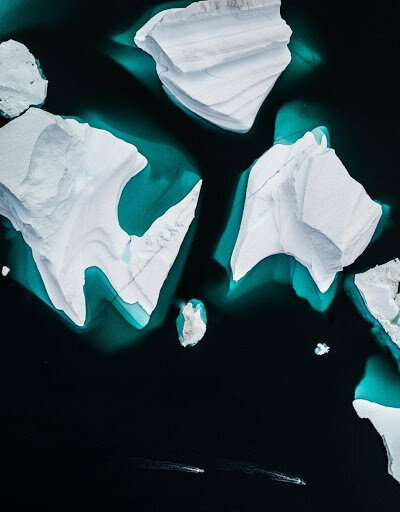A Brief Overview of Arctic Conservation & Climate Change
BY TAYLOR IRWIN
William Bossen, Greenland ocean sunset.
The word “arctic” brings to mind ice, glaciers, polar bears, the North Pole and maybe even Santa Claus! This seemingly barren landscape of ice, snow and water is actually home to 5,500 species of wildlife, many of which live beneath the near freezing water (28.8°F, -1.8°C). Even some of the most long-lived animals found on Earth, the Greenland shark (400 years) and the bowhead whale (200 years), are found in Arctic waters.
This frozen wonderland is located in the Northernmost region of the planet and consists of the Arctic ocean surrounded by land including northern parts of Canada, Russia, Norway, Alaska, and all of Greenland. The climate in the Arctic is very cold year-round and not well suitable for humans. However, indigenous peoples have been settled in Arctic regions for thousands of years and have learned to live off the land in a sustainable way.
Filip Gielda, Town of Aasiaat (Greenland) during winter season
Like so many places on Earth, the Arctic is in trouble. Extremely susceptible to climate change and rising global temperatures, this polar region has already seen a 95% decline in its oldest and thickest ice. What’s even more worrying is that in October of 2020, the lowest average sea ice extent in the Arctic satellite record was documented. Scientists predict that if left unchecked, current carbon emissions could drive the Arctic to be completely ice free in just 20 years.
Annie Spratt, Wild polar bear swimming in the Arctic
Rising sea level is an effect of climate change and occurs when melting sea ice in the poles flows into the oceans. Every coastal community on the planet is susceptible to sea level rise which can cause flooding, increased intensity of storm surges and coastal damage. These detrimental effects have already been observed in recent years with just a 9 inch (23 cm) sea level increase since 1880. If all of the Earth’s sea ice were to melt, sea level would rise by a catastrophic 195 feet (60 meters)!
Annie Spratt, Iceberg at Scoresby Sund, Greenland from above
Another concern about melting sea ice is a decrease in albedo. Albedo is a measure of how much solar radiation is reflected by the Earth’s surface. Sea ice reflects up to 80% of incoming energy whereas sea water reflects just 6%. With less sea ice and more ocean water, there is less energy being reflected and more being absorbed by the Earth. This is a problem because more sunlight energy being absorbed means more warming in the atmosphere which increases the melting of sea ice. This is a clear example of a positive feedback loop which accelerates global warming.
Michael Shannon, Merchants Bay, Canada
Melting sea ice also means more ocean surface becomes available for shipping lanes allowing easier access across continents. In the past, shipping routes such as the Northwest passage and the Northern Sea route have been too dangerous and unpredictable to navigate. But now, the decrease in ice has allowed for further extension and accessibility of these routes. This also opens up more area for offshore oil drilling and the potential for disastrous oil spills. If these passageways were to open up commercially, it could have extremely harmful effects on Arctic ecosystems.
Annie Spratt, Arctic iceberg
Despite the doom and gloom surrounding the Arctic and climate change, it’s not too late to save our sea ice and the creatures that depend on it. Along with nations working together to make the switch from fossil fuels to renewables, there are many organisations working hard to protect the wildness and beauty of the Arctic. Here is a list of some of them:
This organisation fights to protect the Arctic Wildlife Refuge from drilling in the northeast corner of Alaska, home to some of the most pristine nature on Earth. Their vision is to protect Alaska’s wildest places for generations to come.
This Norwegian based organisation aims to implement sustainable solutions to environmental problems. They seek to prevent nations from commercialising oil and gas resources in the Arctic as well as prevent exploitation of the Northern Sea Route.
Circumpolar Conservation Union
CCU works to maintain the ecological and cultural integrity of the Arctic and they support the subsistence way of life of indigenous peoples who live there.
Greenpeace is currently campaigning for a protected marine area around the North Pole in international waters to be included in a network of marine protected areas in the Arctic Ocean. They also aid in stopping oil drilling and defending wildlife in the Arctic.
This Russian based organisation focuses on bringing leaders from different nations together to address political, environmental and economic issues in the Northernmost part of the world.
Polar Bears International aims to conserve polar bear populations and the sea ice on which they live by inspiring the public to care about the Arctic through media, science and advocacy.






